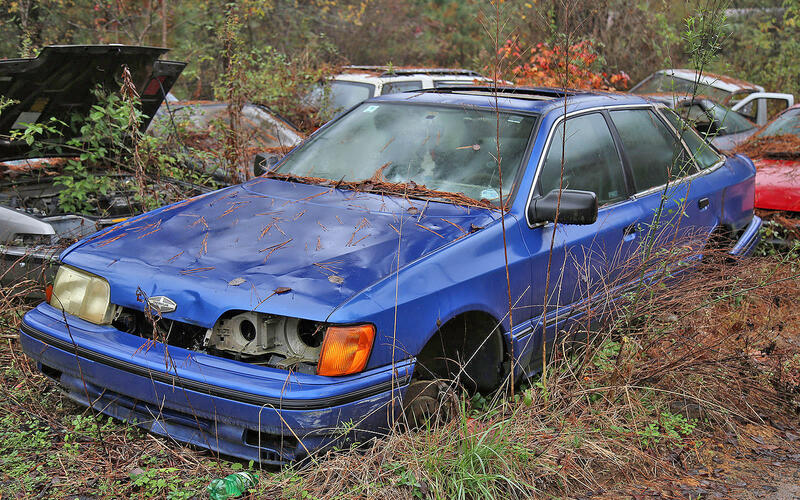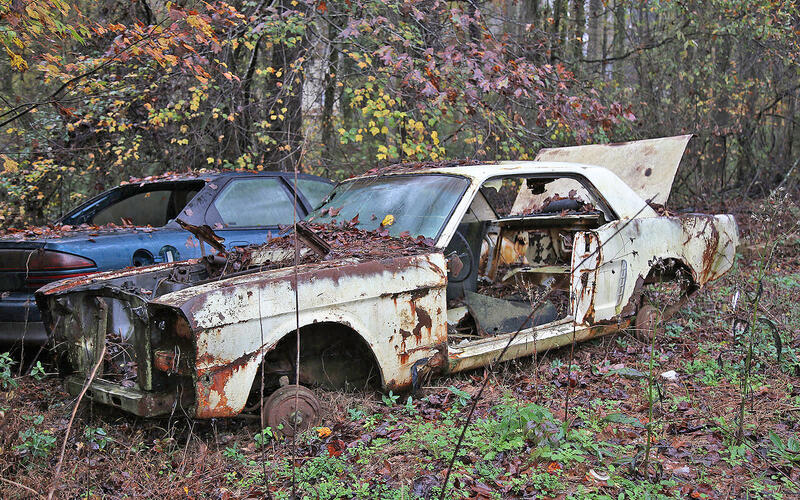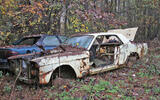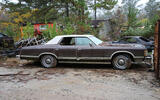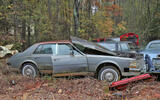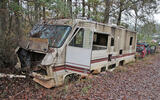 Slide of
Slide of
Auburn, Georgia is home to Collins Auto Salvage, a yard with close to 1000 cars.
At this yard the cars are strewn all over the place instead of being stacked-up neatly on racking, as is the norm these days. In other words, it’s exactly the kind of place we love to explore…
A few years ago we spent a wet November morning digging around in the undergrowth, uncovering this wonderful collections of unloved classics.
 Slide of
Slide of
FORD MUSTANG
This original Ford Mustang must have been a resident of Collins Auto Salvage for many years to have been so extensively picked over. The wings and boot-lid were rusty, and of little use to anyone, leaving the windscreen as one of the few remaining parts worth saving. We’d guess that this has since been fed to the crusher.
 Slide of
Slide of
FORD LTD - 1978
Although the bulk of the inventory dates from the 1990s or newer, we did find a number of 1970s cars too, including this wonderful 1978 Ford LTD Landau. According to the license plate tag, it hadn’t been on the road since 1993, so it’s odd that it still held air in all four of its tyres.
The LTD was 5.18 metres long, and weighed-in at 1764 kg. However, time was quickly running out for cars of these proportions, and the 1978 LTD was 17.8 cm shorter and 318 kg lighter.
 Slide of
Slide of
CADILLAC SEVILLE - 1985
The 1980 Cadillac Seville was certainly eye-catching, thanks to its slant-back styling. The distinctive rear end, which resembled some 1930s saloons, and closely resembled the Daimler DS420 limousine, was actually supposed to appeal to a younger generation who were buying German imports.
Although 200,000 of them were produced (1980-1986), they’re few and far between in salvage yards, making this circa 1985 example something of a rarity.
 Slide of
Slide of
PACE ARROW - 1984
Complete with its signature yellow and orange stripes, this 1984 Pace Arrow Recreational Vehicle didn’t look too different to the mobile drug lab that featured in the first series of Breaking Bad. However Walter White, and Jesse Pinkman in fact cooked up their signature blue drugs in a Fleetwood Bounder.
 Slide of
Slide of
CHEVROLET CORVAIR
We never cease to be amazed at how many Chevrolet Corvairs still turn up in salvage yards. Then again, more than 1.8 million of them were built between 1960 and 1969.
The US’s first and only mass-produced car with a rear-mounted, air-cooled engine, it was supposed to be a direct competitor to the far smaller Volkswagen Bug.
 Slide of
Slide of
CHEVROLET EL CAMINO - 1977
It may have been missing its engine and most of its glass, but this 1977 El Camino Classic’s bodywork was still in great shape.
The 1977 trucks didn’t look a whole lot different to those from the previous year, and featured the same stacked headlights. The key difference was a new grille, with vertical instead of horizontal bars. The big changes would occur in 1978, with the launch of the fifth generation El Camino.
 Slide of
Slide of
FORD FAIRLANE - 1959
This 1959 Ford Fairlane two-door hardtop was one of a handful of 1950s cars we found in the yard. Note all the empty space in the background, which would once have contained a lot more similarly aged classics, now long since crushed. Presumably the straight body panels saved this one from a similar fate.
 Slide of
Slide of
PLYMOUTH VALIANT - 1965
Unfortunately 1965 Plymouth Valiants aren’t particularly valuable or desirable when they’re in good condition, and the situation is even worse when they’re as badly abused as this one. However, acting in this example’s favour was its scarcity. It’s a high-spec V200 two-door sedan, one of just 8919 built. But we doubt if that was enough for someone to save it.
 Slide of
Slide of
CHEVROLET MONTE CARLO - 1977
In 1977 the American automobile industry was downsizing. But while General Motors had already put the Caprice on a diet, the Monte Carlo had another 12 months without having to worry about its weight. A year later it would lose 364 kg and 38 cm in length.
But despite its size, there was no shortage of buyers for Chevrolet’s luxury personal car, which sold 411,038 units. The S coupes, like this one, were slightly more popular than the Landau coupes. The Monte Carlo was built over seven generations, between 1970 and 2007.
 Slide of
Slide of
PLYMOUTH FURY - 1972
And here’s another bloated two-door car from the 1970s - a 1972 Plymouth Fury III. However, despite weighing in at 1723 kg, with a V8 under the hood it could still shift. Though the standard 5.2-litre engine would power the car to 60mph in 13.1 seconds, the Sport Fury GT, with its 7.2-litre V8, did it in a blisteringly quick 7 seconds.
 Slide of
Slide of
PLYMOUTH - 1949
In 1949, when this rolled off the line, Plymouth was America’s third best-selling automobile marque, behind Ford and Chevrolet. In fact it held this number three spot from 1932 to 1954, before dropping a place to Buick.
This example, which had miraculously retained its original wheel trims, was the oldest car we found at Collins Auto Salvage. But that’s not to say there weren’t a few older ones we missed, lurking in the undergrowth.
 Slide of
Slide of
MERKUR SCORPIO
Think automotive flops, and Edsel springs to mind. But let’s not forget that the Merkur marque sold half as many cars, finding just 64,474 buyers in the five years - 1985 to 1989 - it was active in the USA.
The worst seller of its two models was the Scorpio, a rebadged German-built Ford Granada. Despite being a decent car, only 22,010 people were prepared to hand over the required $26,000 to drive one of them out of a Lincoln-Mercury showroom.
 Slide of
Slide of
CAPRI
In contrast to the Scorpio, here’s a captive import that sold well. Designed in the UK and built in Germany, the Capri and Capri II were marketed by Lincoln-Mercury dealerships between 1970 and 1978. When this early 1970s example was sold, the Capri was the second most popular imported car after the Volkswagen Bug, and in total 513,500 were sold.
 Slide of
Slide of
PONTIAC LE MANS - 1979
Ignoring the rotten interior, this 1979 Pontiac Le Mans coupe still had plenty of great parts to offer. Then again, we can’t imagine too many people would have been interested in restoring one, so we suspect it will have probably ended up in the crusher. Of the 68,670 Le Mans built that year, less than a quarter were coupes.
 Slide of
Slide of
FORD MAVERICK
Here’s an equally undesirable car from the same era, a Ford Maverick four-door sedan. As well as battling it out with the Chevrolet Nova and Dodge Dart, the Maverick was designed to tackle the growing threat from small Japanese cars.
While it didn’t set the world alight, it did sell well, with Ford producing 2.1 million units between 1969 and 1977. The nameplate has proved useful too, which is now used on a popular compact pickup truck.
 Slide of
Slide of
FORD FAIRLANE - 1958
It’s hard to imagine that this 1958 Ford Fairlane was new once. For the first few years of its life, its proud owner would have washed and polished it every weekend.
They’d have checked out their reflection in its gleaming chrome and shiny paintwork, and likely gone into a month-long depression at discovering the first scratch. Those days had long since passed by the time we photographed it…
 Slide of
Slide of
FORD ECONOLINE
Nothing screams the early 1980s like a brown and gold Ford Econoline day van. Unfortunately it was in a bad way, which is a shame, as it might have made a great restoration project for somebody. The E-Series has been in production for more than 60 years, making it one of Ford’s longest running models. Although sales have fallen sharply since the launch of the Transit, it still sells in excess of 30,000 units per year. More than 3 million have been produced so far.
 Slide of
Slide of
TOYOTA CELICA GT
Just like the Ford Mustang, the Toyota Celica was a sportscar based on a boring sedan – in this instance a Carina. This GT is a first generation car, and was probably built in 1975. If so, it would have been fitted with 5mph safety bumpers.
 Slide of
Slide of
BUICK ELECTRA PARK AVENUE - 1982
We know this isn’t the most exciting car in the world, but Buick Electra Park Avenues of this era are disappearing fast, so we reckon it deserves a place in this collection. It’s a 1982 coupe, and although a bit battered and bruised, it appeared to be mainly rust-free. Of the 76,232 built that year, just 8182 had two doors.
 Slide of
Slide of
CHEVROLET BELAIR - 1962
This 1962 Chevrolet Bel Air had done well to survive for this long. However, seeing as most of its body panels were riddled with rust, we reckon its days may have been numbered. The famous Bel Air name was used on American Chevrolets from 1950 through to 1975, and continued for a further six years in Canada.
If you enjoyed this story, please click the Follow button above to see more like it from Autocar
Access control:
Open
Include in Apple News:

